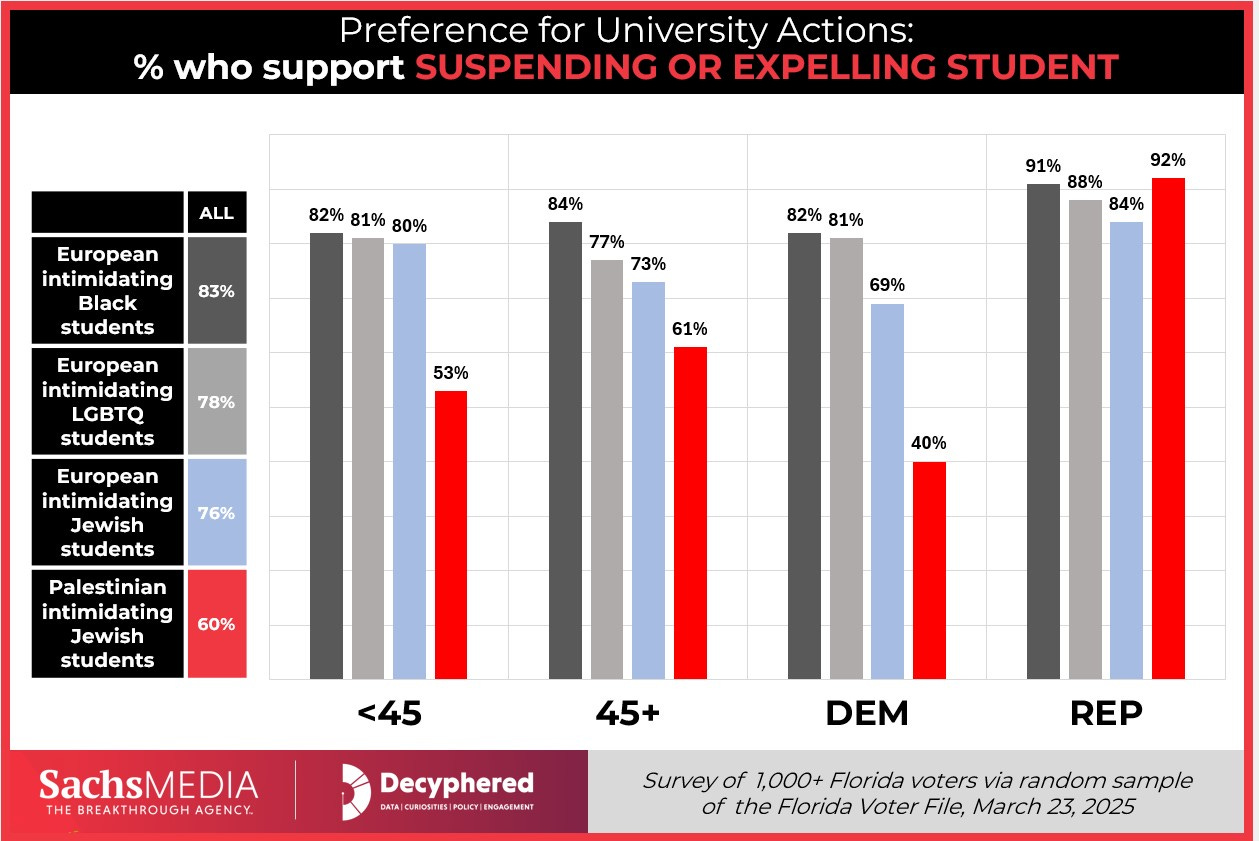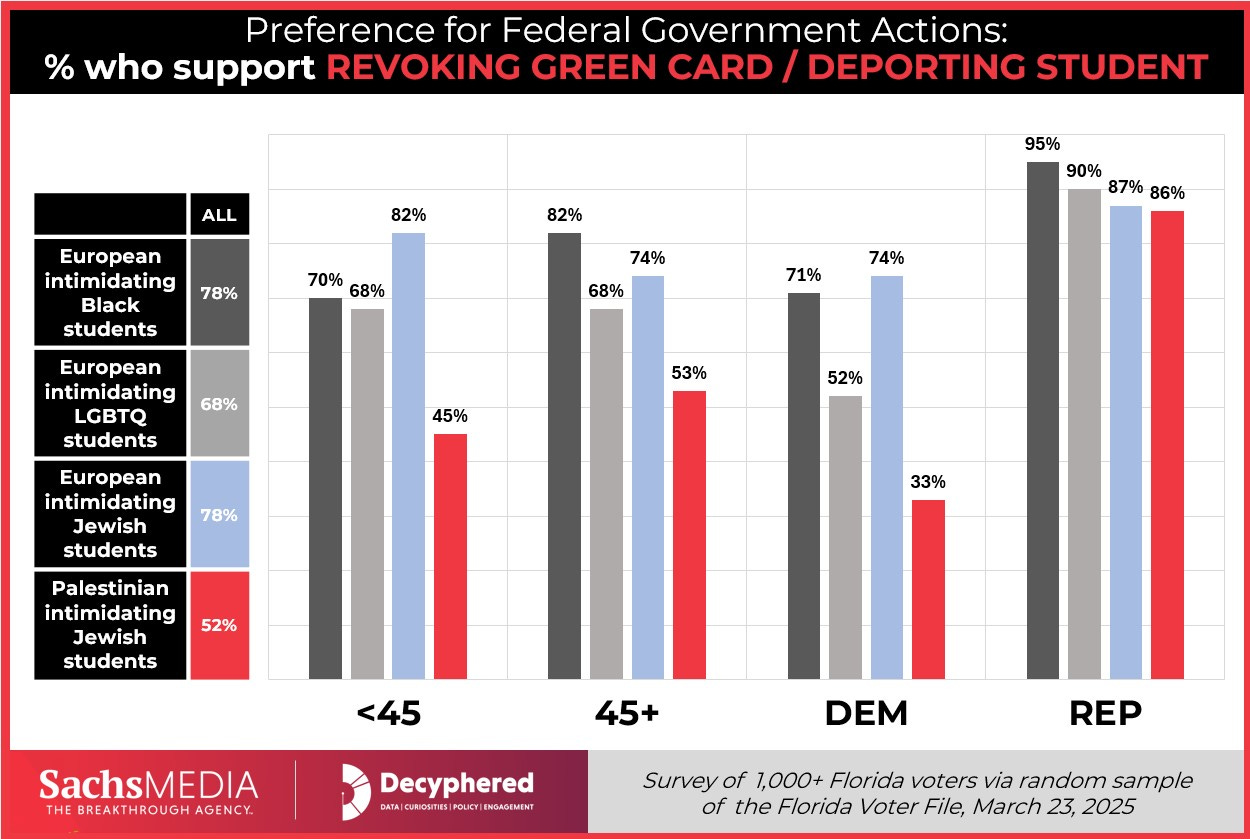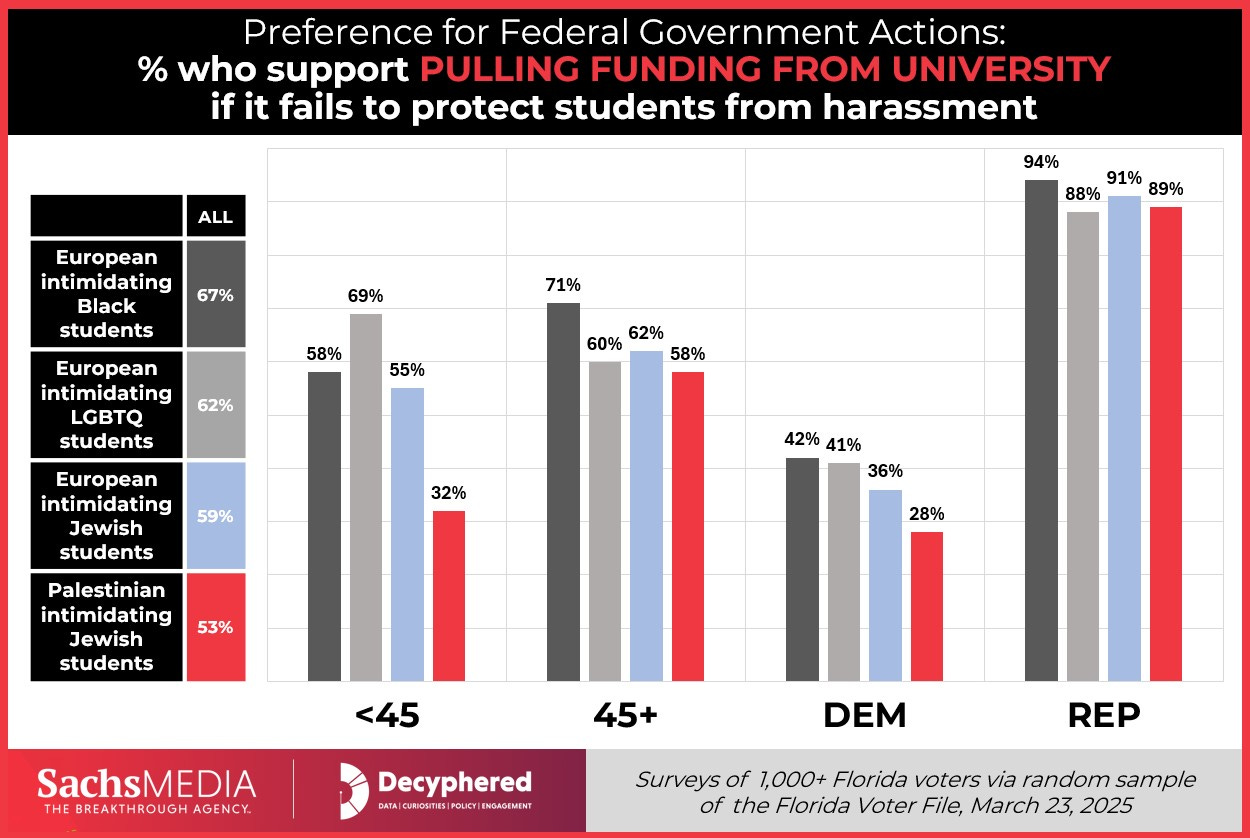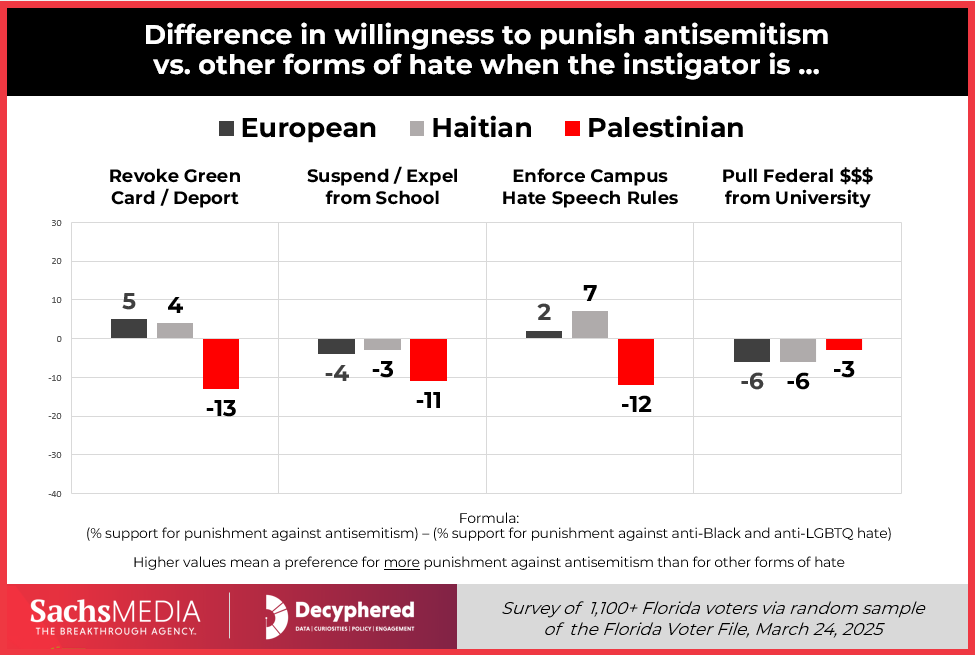When the victims are Jewish, the rules suddenly change.
We changed one detail in an antisemitism report. Watch what happens.
Please consider supporting our mission to help everyone better understand and become smarter about the Jewish world. A gift of any amount helps keep our platform free of advertising and accessible to all.
This is a guest essay written by Karen Cyphers, a public opinion researcher.
You can also listen to the podcast version of this essay on Apple Podcasts, YouTube Music, YouTube, and Spotify.
It started with social media posts I saw in the wake of the detention of Palestinian activist Mahmoud Khalil1 for his role in protests at Columbia University — protests that included intimidation and harassment of Jewish students, vandalization of property, dissemination of materials produced by Hamas and terrorist affiliates, celebration of Jihad, and disruptive campus shutdowns.
I noticed a particular argument circulating that reads (at least to this researcher) as a testable hypothesis:
“If Khalil were a white student targeting Black or LGBTQ students, he’d be expelled and deported without hesitation. But when the targets are Jewish, and the perpetrator Palestinian, suddenly universities freeze — or worse, defend the aggressor.”
To test whether this provocative assumption may be true, we conducted a randomized experiment to measure how people feel about punishing aggressive campus protests and answer these questions:
Is antisemitism on campus really treated more leniently than other forms of hate?
And if so, is it about the identity of the victim and/or aggressor?
For those who don’t want to read any further, the “too long, didn’t read” answer is “yes” to all of the above: Many people hold striking double standards when it comes to punishing antisemitic behavior, and these biases are influenced by the identity of the victims and the aggressors alike.
These survey findings are relevant to ongoing debates about the First Amendment2 to the United States Constitution and immigration policy, especially when those conversations reference public sentiment.
While many are earnest in their concerns, for too many others, outrage is conditional based on the identity or politics of who is aggressing, and which group they target.
For those who do want to learn more, here’s how we got here.
Experiment 1
To begin to answer these questions, we ran a randomized experiment with over 1,000 Florida voters — a representative mix of ages, backgrounds, and political affiliations. Each person was shown one of four student profiles describing a foreign college student involved in a hate group that intimidates others on campus.
The four profiles were nearly identical except for two things:
Who the aggressing student was, and
Who they were targeting.
Here’s what we showed:
Profile A – European student who intimidates Black students
Profile B – European student who intimidates LGBTQ students
Profile C – European student who intimidates Jewish students
Profile D – Palestinian student (Mahmoud Khalil, named and described factually) who intimidates Jewish students
A few notes about methodology are important to include here:
The mock European student profile, in all cases, greatly resembled (explicitly, in one case) what one might assume is a Right-wing neo-Nazi or white supremacist.
The details describing the activities of each foreign student are a match for the things Khalil is under scrutiny for.
The European student’s photograph was created using AI to create a European match for Khalil himself, wearing the same clothing and with the same facial expression.
Profiles A, C, and D each referred to a “designated terrorist group” that celebrates the murder of a category of people (Black or Jewish), while Profile B regarding LGBTQ students referred instead to a “designated hate group” and didn’t reference terrorism or murder, just harassment.
This is important to note, since this distinction may account for some of the differences we’ll see in public preferences for punishment (i.e., respondents may be more inclined to punish a student activist for affiliation with a group that threatens or celebrates murder rather than “merely” harassment).
After seeing one of these four profiles, respondents were asked how the university and government should respond.
Should the student be expelled or suspended?
Should their green card be revoked?
Should hate speech rules be enforced?
Should the university be penalized for not protecting students?
This experiment wasn’t asking people to weigh in on constitutional rights or immigration law. We simply wanted to know how people feel when they encounter different versions of the same story, different only in the identities of the aggressor or the harassed.
Results of Experiment 1: Double Standards Identified
Across the board, respondents were strongly in favor of disciplinary and legal consequences when the profiled student described was European and the targets were Black, LGBTQ, or Jewish students.
But that support shifted dramatically when the aggressor was Palestinian and the targets were Jewish, especially among Democrats and younger voters.
Should the student be expelled or suspended?
Take the most basic question: Should the student be suspended or expelled?
Across demographic groups, the following shares of each treatment group felt the aggressing student should be suspended or expelled:
83 percent – European student intimidating Black students
78 percent – European student intimidating LGBTQ students
76 percent – European student intimidating Jewish students
60 percent – Palestinian student intimidating Jewish students
Among Democrats, 82 percent supported suspension or expulsion when the student was European and harassing Black students, and 81 percent felt the same when the European student was harassing LGBTQ students.
That portion dropped to 69 percent when it was a European student harassing Jewish students, and dropped by more than half to just 40 percent among Democrats considering the Palestinian intimidating Jewish students — a staggering 42-point difference from the feeling when a European student was intimidating Black students.
Among voters under the age of 45, the difference was nearly as stark: Support for suspension or expulsion went from 82 percent of those who saw the European student intimidating Black students, to 53 percent among those who saw the Palestinian student intimidating Jewish students.
Among Republicans, support for suspension or expulsion was fairly consistent, no matter the aggressor or the victim: 91 percent among those who saw a European intimidating Black students, 88 percent among those who saw a European intimidating LGBTQ students, 84 percent among those who saw a European intimidating Jewish students, and 92 percent among those who saw a Palestinian intimidating Jewish students.
Should the university enforce its own codes on hate speech?
Even larger portions of Floridians overall support universities enforcing campus rules about hate speech, with somewhat less variation in the aggregate:
87 percent – European student intimidating Black students
83 percent – European student intimidating LGBTQ students
87 percent – European student intimidating Jewish students
74 percent – Palestinian student intimidating Jewish students
Once again, however, those younger than 45 significantly prefer enforcement of hate speech rules when the aggressor is European than when the aggressor is Palestinian. Specifically, 88 percent of young respondents felt that campus hate speech rules should be enforced when the offending student looks like a neo-Nazi — but just 53 percent feel the same when the offending student is described as Palestinian.
A similar pattern is seen among Democrats: 94 percent want campus hate speech rules to be enforced when a neo-Nazi student espouses anti-Jewish hate, but just 69 percent feel this way regarding a Palestinian student espousing the same views.
Should the federal government revoke the student’s green card or deport them?
When it came to whether the student’s green card should be revoked or deportation pursued, the disparities widened even more.
Overall, support for these actions is expressed by:
78 percent – European student intimidating Black students
68 percent – European student intimidating LGBTQ students
78 percent – European student intimidating Jewish students
52 percent – Palestinian student intimidating Jewish students
Among Democrats, the wish to see the aggressor penalized with deportation or revocation of his green card fell from 74 percent for the European harasser of Jewish students to just 33 percent for the Palestinian one, a 41-point decline. Among voters under 45, support dipped from 82 percent to 45 percent.
Among Republicans, support for this form of punishment was significantly higher across the board, but with far less variation between treatment groups: 95 percent for the European student harassing Black students, 90 percent for harassment of LGBTQ students, 87 percent for European harassing Jewish students, and 86 percent for a Palestinian doing the same.
Should federal funding be pulled if universities fail to protect students from harassment?
Finally, we asked whether universities should lose federal funding if they fail to protect students from harassment — something that has recently been initiated by the Trump administration.
Overall, support for the federal government pulling funding from these universities registers at:
67 percent – European student intimidating Black students
62 percent – European student intimidating LGBTQ students
59 percent – European student intimidating Jewish students
53 percent – Palestinian student intimidating Jewish students
Again, Democrats were far more supportive of that punishment when the aggressor was European and the victims were Black (at 42 percent) than they were when the aggressor was Palestinian and the victims were Jewish (28 percent).
Among younger voters, support for this punishment dropped from 58 percent to just 32 percent. And again, Republicans express fairly consistent preferences for punishment regardless of the identity of the aggressor or victim.
Experiment 2
I ran these results past Bryan Tomlin, an economics professor at California State University Channel Islands, who conducts antisemitism research for the Anti-Defamation League (ADL).
Seeing that respondents were so much more willing to punish a European aggressor than a Palestinian one for the same offenses, he questioned whether this was due to sympathy for the conditions that the student might return to if deported to their home country.
Indeed, the thought of returning a student to Palestine, an active war zone, might feel proportionally more punishing than returning a student to Poland.
This led to two additional questions:
Would people be equally hesitant to deport a Palestinian student for instigating protests that led to the intimidation of Black or LGBTQ students?
Would people be equally hesitant to deport a student from a country such as Haiti3, which has similar levels of health, development, and upheaval, as they are for a Palestinian student?
In order to test these questions — and to assure myself that our findings weren’t an artifact of something else entirely — we went back into the field just one day later with a completely separate survey of 1,228 Florida voters. This time, respondents were randomly assigned to view one of four foreign student profiles that were used the same language as the original profiles, but with the following options:
Profile E – Palestinian instigating against Black students
Profile F – Palestinian instigating against LGBTQ students
Profile G – Haitian instigating against Jewish students
Profile H – Haitian instigating against LGBTQ students
Results of Experiment 2: Double Standards Confirmed
Even when controlling for the aggressor’s country of origin, strong double standards remain when it comes to Palestinian acts against Jews.
Overall, when the aggressor is from Poland or Haiti, the desire to punish them for antisemitism is as strong or stronger than the desire to punish them for comparable acts that target Black or LGBTQ students.
However, when the aggressor is from Palestine, there is a complete reversal: Suddenly, in this pairing, the desire to punish antisemitism falls precipitously compared with the willingness to punish that same hypothetical Palestinian student for anti-Black or anti-LGBTQ acts. This holds true both for severe forms of punishment, such as revoking the student’s green card, and for punishments that aren’t specific to the student at all, such as the desire for campuses to enforce hate speech rules.
Specifically, we found that when the aggressor is described as European or Haitian, deportation is preferred as a punishment for antisemitism by five percentage points more people than with other types of hate speech, such as against Black or LGBTQ students. But when the aggressor is Palestinian, the preference for deportation is 13 percentage points lower when the target group is Jews compared with identical crimes against Black or LGBTQ targets.
Similarly, when the aggressor is European or Haitian, five percentage points more people prefer enforcement of hate speech rules against antisemitism than when this hate speech is directed at Black or LGBTQ targets. But when the aggressor is Palestinian, support for this type of punishment is 12 points lower than it is for other forms of hate speech.
These differences are even more significant among younger and Left-leaning respondents. For example: When Floridians under age 45 consider a European or Haitian aggressor, they prefer enforcement of campus hate speech rules for anti-Jewish rhetoric by 17 points higher than for other types of hate speech.
But when the aggressor is described as Palestinian, respondents prefer enforcement of campus hate speech rules for antisemitism by 31 points lower than they do for equal offenses by that same student against Black or LGBTQ students.
Why do so many give the Palestinian activist a pass for antisemitism while others get punished?
In every case, the facts of the incident were the same: a foreign student affiliated with a hate group intimidating fellow students on campus. But when the identity of the aggressor shifted from a European to a Palestinian and the targets remained Jewish, public willingness to call for action fell off a cliff.
At first glance, this might look like a contradiction. If you’re outraged by hate speech and harassment and if you support tough action when a European, Haitian, or Palestinian student is intimidating Black or LGBTQ students, shouldn’t you also support action when a Palestinian student targets Jews?
But people don’t process these scenarios in a vacuum.
When the aggressor was a Palestinian student targeting Jews, the response became muddied, especially on the political Left. To many of these respondents, his behavior was interpreted as less condemnable than that of others described doing the same thing.
Why It Matters If Ideology Matters
Campuses around the world are struggling to draw clear lines around hate speech, protest, harassment, and safety. Some of that struggle is legal. But some of it is cultural, shaped by how we, as a public, interpret and weigh these situations. These findings seem to speak directly to how universities, government officials, and the public handle real-world controversies, especially when antisemitism is involved.
This data suggests that:
When it comes to punishing antisemitism, public attitudes are not applied consistently across different aggressors and target groups. For some reason, many people are willing to look the other way when the aggressor is Palestinian and the targets are Jews — while quite willing to punish that same Palestinian aggressor for identical acts against other groups of people.
When the aggressor fits the mold of a Right-wing extremist, like a European neo-Nazi, the moral calculus is simple: People overwhelmingly support enforcement. And, when the aggressor is Palestinian and committing acts against Black or LGBTQ students, a strong preference for punishment remains. Only when the aggressor is seen through the lens of activism, as in the case of a Palestinian student protesting in ways that make Jewish students feel unsafe, the same behavior is rationalized, and the consequences softened.
Some of the outrage about Khalil’s detainment isn’t purely about the First Amendment or immigrant rights. If that were the case, a hypothetical European or Haitian student accused of identical offenses to Khalil should be seen as equally worthy of legal protections. But to the contrary, far more respondents express a willingness to revoke the green card of an antisemitic neo-Nazi, a homophobe, or a racist (of any national origin) than they are to similarly punish a Palestinian supporter of Hamas.
Our previous survey research has revealed stark double standards against Jews and Israel regarding self-defense, religion, and diplomacy. The results of this survey are a bit more complex: They signal that the social or political motivations of the agitator deeply influence who gets protected, or who gets a pass on punishment.
This raises critical questions about the role of political and social narratives in shaping perceptions of hate: Are people more inclined to excuse antisemitism when it aligns with a preferred geopolitical narrative? Do certain aggressors receive more leniency due to perceived victimhood?
Understanding these inconsistencies is essential for developing fair and principled policies that address hate-based intimidation in all its forms, without selective enforcement based on the identity of the aggressor or the target.
These experiments don't tell us what the “correct” policy is; that’s not the goal. But it does shine a light on how uneven public opinion can be, and how easily our moral instincts shift when identity and politics get involved.
Maybe the better question isn’t just: “What if the student had been a neo-Nazi?” Maybe it’s: “Why do we protect some students more than others, depending on who’s doing the harassing?”
And maybe it’s time we stop letting ideology dictate which victims count, no matter who targets them.
A top activist in a Columbia University group that had celebrated the October 7th attacks and called for the destruction of America
The First Amendment to the United States Constitution, part of the Bill of Rights, guarantees five fundamental freedoms: religion, speech, press, assembly, and petition.
According to data from the United Nations Human Development Program, Haiti and Palestine are comparable in how they rank on the Human Development Index, which is a calculation of economic, health, and well-being data. In fact, Haiti ranks lower than Palestine on this index, and — as many Floridians know — is also in a state of political upheaval with significant surges in violence.










Karen Cyphers, this is beautiful. I have been feeling and knowing this, and seeing it scientifically confirmed at least counters the gaslighting. Thank you!
I have been so affected by constant denial of Jewish suffering that I want to blog about what it's like to be a Jew right now. We'll see if that yearning converts to action. :-). Thank you for the time and care you took to confirm what feels so subtly present in so much media, these days.
So true. At my uni the prof who has called Jews filth and has thousands of anti semetic posts plus three human rights complaints. No sanction. Zip. Me? Called Hamas Nazis. Suspended 17 months. Will be fired.
No https://open.substack.com/pub/paulfinlayson/p/is-the-university-of-guelph-the-modern?r=iy2ds&utm_medium=ios